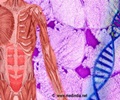A genetic diagnosis at last, 30 patients with previously undiagnosed FLVCR1 mutations reveals the gene's critical role in neurodevelopment and anemia.

Biallelic variation in the choline and ethanolamine transporter FLVCR1 underlies a severe developmental disorder spectrum
Go to source).
‘FLVCR1 mutations affect #choline and ethanolamine transport, important for cell function. This finding could reshape treatments for rare #neurodevelopmental disorders! #genomics #medindia’





"The story of our findings started with one patient I saw in the clinic presenting an uncommon combination of problems," said Dr. Daniel Calame, who teaches developmental neurosciences and pediatric neurology at Baylor. It was highly unusual for the patient to have epilepsy, severe developmental disorders, and total insensitivity to pain. Neurologists and geneticists had performed many tests, but the condition was never diagnosed.
Calame enrolled the patient in the BCM GREGoR (Genomics Research to Elucidate the Genetics of Rare Diseases) research program. “We reanalyzed the patient’s genetic and clinical data and that brought us to a gene, FLVCR1, and a medical mystery to solve,” Calame said.
One Gene Multiple Condition
To understand how the rare FLVCR1 mutation in the patient could lead to the condition, they researched scientific literature on this gene. Current evidence indicates that the FLVCR1 protein plays a key role in the production of red blood cells and in the transport of choline and ethanolamine in cells.Choline and ethanolamine are important for cells. They are precursors for phosphatidylcholine and for phosphatidylethanolamine, respectively, which are required for cell membrane integrity needed to support cell division and other essential cellular functions.
Advertisement
The embryos have many bone malformations in the head and limbs and defective production of red blood cells, which is reminiscent of Diamond-Blackfan anemia (DBA) in people. But this was different from what they saw in patients.
Advertisement
In addition, other studies found rare defective copies of the FLVCR1 gene in patients with childhood or adult-onset ataxia, a condition characterized by poor muscle control and incoordination, who also had sensory problems and retinitis pigmentosa, or progressive vision loss. These problems also were not like those Calame was seeing in his patient.
“We were intrigued. On one hand, we had a patient with a rare FLVCR1 mutation and severe developmental conditions, epilepsy and complete insensitivity to pain, but on the other hand there were patients with rare mutations on the same gene that presented with a different set of problems,” Calame said.
“Could it be that those different mutations of FLVCR1 caused not one set but a spectrum of characteristics we observed in all the patients combined?”
Decoding FLVCR1: Genetic Clue to Rare Diseases
The research team tackled the FLVCR1 gene mystery using two strategies. First, they expanded their patient pool by identifying individuals with neurodevelopmental disorders and rare FLVCR1 variants through specialized databases, including BCM GREGoR and GeneMatcher, ultimately identifying 30 patients from 23 families.They found 22 unique gene variants, 20 of which were previously unknown, with affected patients displaying developmental delays, microcephaly, brain malformations, and anemia.
Second, in collaboration with Dr. Long Nam Nguyen’s team, they studied the functional effects of these FLVCR1 variants in the lab. They discovered that these mutations reduce choline and ethanolamine transport by up to half, affecting neurodevelopment and potentially determining disease severity.
Other studies have shown that choline is required for normal neurodevelopment and that its deficiency also causes anemia, liver disease, growth retardation and immune deficiency. “Neurodevelopment is also disrupted by defective choline uptake, and we showed that the variants in our patients do reduce choline transport,” Calame said.
Altogether, the findings demonstrate that FLVCR1 variants cause a broad spectrum of developmental problems ranging from severe multiorgan developmental disorders resembling DBA to adult-onset neurodegeneration.
The variants identified in patients reduce choline and ethanolamine transport in cells in the lab, suggesting that transport of these molecules into the central and peripheral nervous systems is essential to prevent neurodegeneration and required for normal neurodevelopment.
This highlights the importance of incorporating both genetic data and animal model studies into the diagnostic process, particularly for rare diseases, where clinical manifestations can vary widely across patients. The identification of FLVCR1 as the cause of these disorders opens new avenues for understanding and treating conditions that were previously difficult to diagnose or understand.
- Biallelic variation in the choline and ethanolamine transporter FLVCR1 underlies a severe developmental disorder spectrum - (https:www.gimjournal.org/article/S1098-3600(24)00207-7/abstract)
Source-Eurekalert













